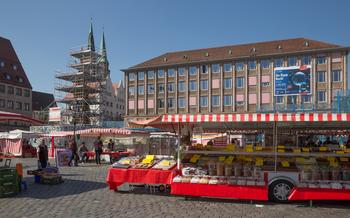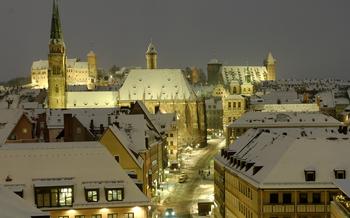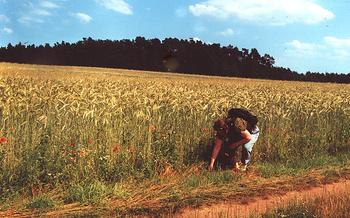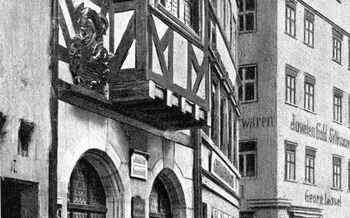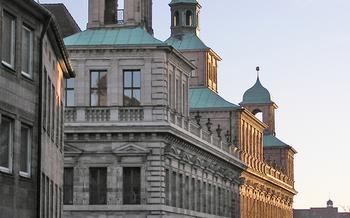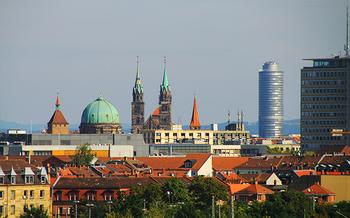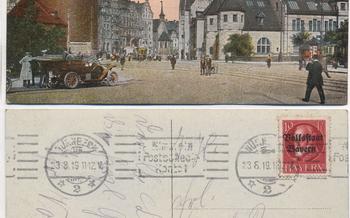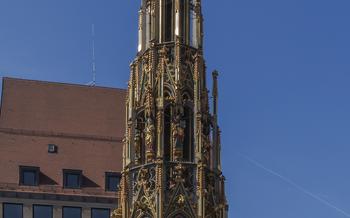
Beautiful Fountain (Schöner Brunnen)
- Historical Significance
- Location and Accessibility
- Description of the Fountain
- The Statues and Figures
- The Golden Ring
- The Four Seasons
- The Water Show
- The Market Square
- Nuremberg's Christmas Market
- The Altstadt (Old Town)
- The Handwerkermarkt (Artisan Market)
- The Imperial Castle
- The German National Museum
- The Albrecht Dürer House
- Insider Tip
Historical Significance
The Schöner Brunnen, meaning "Beautiful Fountain" in German, stands as a testament to Nuremberg's rich history and artistic heritage. Its construction began in 1385 under the patronage of the Holy Roman Emperor Charles IV and was completed in 139The fountain's design was influenced by Gothic architecture and the artistic style of the time. It serves as a reminder of Nuremberg's status as a prominent imperial city and a center of trade and culture in the Middle Ages. Throughout its existence, the fountain has witnessed many significant events, including imperial processions, market days, and religious festivals. It has become an iconic symbol of Nuremberg and a beloved landmark for both locals and visitors alike.
Location and Accessibility
The Schöner Brunnen is situated in the heart of Nuremberg, at the bustling Hauptmarkt (Market Square). This central location makes it easily accessible by foot, public transportation, or car.
If you prefer to walk, the fountain is just a few minutes away from the city's main train station, Nuremberg Hauptbahnhof. Simply follow the signs to the Hauptmarkt, and you'll find the fountain in the center of the square.
For those arriving by public transportation, there are several bus and tram lines that stop near the Hauptmarkt. The closest stop is "Hauptmarkt," served by bus lines 36, 46, and 63, as well as tram lines 4 and
If you're driving, there are several parking garages located within walking distance of the fountain. The closest one is the "Parkhaus Hauptmarkt," which is just a few steps away from the square.
Once you arrive at the Hauptmarkt, you can't miss the Schöner Brunnen. It stands proudly in the center of the square, surrounded by historical buildings, shops, and restaurants.
Description of the Fountain
The Schöner Brunnen rises majestically in the heart of Nuremberg's Hauptmarkt, a testament to the city's rich history and artistic prowess. Standing at an impressive 19 meters, the fountain's intricate design and elaborate ornamentation captivate the eyes. Constructed from golden bronze and sandstone, the fountain boasts a hexagonal base adorned with intricate carvings and reliefs that depict scenes from the Old Testament, Roman history, and medieval legends. The central pillar, known as the "Schöne Säule," soars upwards, featuring four allegorical figures representing the virtues of Justice, Temperance, Fortitude, and Prudence. Atop the pillar, a Gothic spire adorned with delicate tracery and finials reaches towards the sky, creating a sense of awe and grandeur.
The Statues and Figures
The Schöner Brunnen is adorned with a total of 40 statues and figures, each holding a unique significance and symbolic meaning. Among the most notable figures are the four virtues: Fortitude, Justice, Temperance, and Prudence, depicted as female figures representing the essential qualities of a just and harmonious society.
Standing tall at the pinnacle of the fountain is the figure of Moses, holding the Ten Commandments, symbolizing the moral and ethical foundation of society. Other biblical characters include the prophets Isaiah, Daniel, and Jeremiah, representing the connection between the fountain and the spiritual realm.
Historical figures are also featured prominently, including Charlemagne, the first Holy Roman Emperor, and seven electors who played a crucial role in selecting the emperor. These figures embody the political and historical significance of Nuremberg as a center of power and influence.
Each figure is intricately crafted with distinct facial expressions, garments, and attributes, reflecting the artistic mastery and attention to detail that went into the creation of the Schöner Brunnen. Together, these statues and figures form a harmonious ensemble that tells a story of faith, justice, power, and the interconnectedness of human and divine realms.
The Golden Ring
The Schöner Brunnen is not just a beautiful work of art but also a source of fascination and intrigue. At the base of the fountain, you'll find a golden ring that has become an integral part of the fountain's allure. According to legend, if you make a wish and turn the ring three times clockwise, your wish will be granted. This tradition has been passed down for centuries, and many visitors to Nuremberg make sure to try their luck.
The golden ring has its roots in a medieval belief that touching a golden object could bring good fortune. In the case of the Schöner Brunnen, the ring is said to have been added in the 16th century. Over time, the tradition of making a wish while turning the ring became more widespread, and today it is one of the most popular things to do in Nuremberg.
Folklore and legends have sprung up around the golden ring, adding to its mystique. One legend tells of a young woman who was so desperate to find a husband that she made a wish at the fountain every day. After a year of wishing, her wish finally came true, and she married a wealthy merchant.
Whether you believe in the power of the golden ring or not, it's a fun and harmless tradition that adds to the charm of the Schöner Brunnen. So, if you're ever in Nuremberg, don't forget to make a wish and turn the ring. Who knows, your wish might just come true!
The Four Seasons
The Schöner Brunnen also features a captivating representation of the four seasons. Four elegant female figures, each symbolizing a different season, gracefully adorn the fountain's basin. Spring, depicted as a young maiden crowned with flowers, exudes a sense of renewal and rejuvenation. Summer, personified by a woman holding a sickle and a wreath of wheat, represents the abundance and warmth of the harvest season. Autumn, portrayed as a matronly figure bearing a basket of fruits, signifies the time of gathering and plenty. Finally, Winter, embodied by an old woman wrapped in a fur cloak, symbolizes the cold and dormant period of the year.
The symbolism of the four seasons goes beyond mere representation. It serves as a profound reminder of the cyclical nature of life, the ever-changing rhythms of the natural world. The fountain encourages contemplation of the transient beauty of each season, urging us to appreciate the unique gifts and challenges that each phase of life brings.
The Water Show
The Schöner Brunnen is not just a beautiful work of art but also a stage for a captivating water show. Every day, from April to October, visitors can witness a mesmerizing spectacle of water jets, lights, and music that brings the fountain to life. The show takes place twice a day, once in the morning and once in the evening, and lasts for about 15 minutes.
The water show begins with a gentle cascade of water jets that gracefully flow from the fountain's upper tiers, creating a soothing and tranquil atmosphere. As the show progresses, the water jets become more dynamic, shooting up into the air in graceful arcs and spirals. The water droplets catch the sunlight, creating a dazzling display of rainbows and reflections.
The water show is accompanied by a captivating musical score that enhances the experience. The music ranges from classical compositions to modern melodies, creating a harmonious blend of sound and water. The combination of lights, water, and music creates a magical and enchanting atmosphere that leaves visitors spellbound.
The water show at the Schöner Brunnen is a must-see for anyone visiting Nuremberg. It is a unique and unforgettable experience that showcases the city's rich history, artistic heritage, and innovative spirit. So make sure to check the schedule and plan your visit accordingly to witness this extraordinary spectacle.
The Market Square
The Schöner Brunnen is the centerpiece of Nuremberg's bustling Hauptmarkt (Market Square). The square, steeped in history, was once the heart of the city's commercial activities. Merchants from all over Europe converged here, trading goods, ideas, and cultures. The fountain's location within the square symbolizes its significance as a gathering place, a witness to the city's vibrant past.
Today, the Market Square continues to be a focal point of Nuremberg's urban life. Stalls selling fresh produce, flowers, and local delicacies line the cobblestone streets, creating a vibrant atmosphere. Boutiques, cafes, and restaurants with outdoor seating invite visitors to linger and soak up the lively ambiance. The square hosts various events throughout the year, including concerts, markets, and festivals, further enhancing its status as a beloved meeting point for locals and tourists alike.
Nuremberg's Christmas Market
The Schöner Brunnen stands as a majestic centerpiece within the Hauptmarkt, which transforms into a magical winter wonderland during the renowned Nuremberg Christkindlesmarkt. The square exudes a festive aura, adorned with twinkling lights, wooden stalls, and the sweet scent of gingerbread in the air. Shoppers can immerse themselves in a treasure trove of handcrafted ornaments, traditional toys, and unique gifts, while the aroma of mulled wine and roasted chestnuts fills the air. The fountain, garlanded with festive decorations, adds a touch of enchantment to the already captivating atmosphere. The Nuremberg Christkindlesmarkt is a feast for the senses, offering a unique blend of history, culture, and holiday cheer.
The Altstadt (Old Town)
The Schöner Brunnen stands as a focal point within Nuremberg's captivating Altstadt, a historical treasure trove that beckons with its medieval charm. Immerse yourself in the allure of this ancient quarter, where cobblestone streets meander past half-timbered houses, each narrating tales of a bygone era. Embark on leisurely walking tours or guided visits to unveil the Altstadt's hidden gems, tracing the footsteps of history as you explore its landmarks and attractions. Discover the opulent Frauenkirche, with its Gothic grandeur, or delve into the depths of the labyrinthine underground tunnels, remnants of a forgotten past. The Albrecht Dürer House, a testament to the artistic brilliance of the Renaissance, awaits your visit, while the Imperial Castle, perched majestically atop a hill, offers panoramic vistas that will leave you breathless. The Altstadt pulsates with life, inviting you to savor its vibrant atmosphere, whether it's browsing through quaint shops, indulging in culinary delights at traditional restaurants, or simply soaking in the charm of this enchanting old town.
The Handwerkermarkt (Artisan Market)
Periodically, the area surrounding the Schöner Brunnen transforms into a vibrant Handwerkermarkt, or Artisan Market. This lively event showcases the skills and creativity of local artisans, who gather to present their handmade goods and traditional products. From intricately carved wooden crafts and hand-blown glass ornaments to unique jewelry and pottery, the market offers a treasure trove of unique finds.
Immerse yourself in the bustling atmosphere as you browse the stalls, admiring the craftsmanship and interacting with the friendly vendors. Watch skilled artisans demonstrate their traditional techniques, passing down generations of knowledge and passion. The Handwerkermarkt is not just a shopping experience but also a celebration of Nuremberg's rich cultural heritage.
Whether you're looking for a special souvenir, a one-of-a-kind gift, or simply want to soak up the lively ambiance, the Handwerkermarkt is a must-visit for any traveler to Nuremberg. Don't miss the opportunity to experience the creativity and craftsmanship that make this city so special.
The Imperial Castle
The Schöner Brunnen stands in close proximity to the Kaiserburg, also known as the Imperial Castle. This historic fortress, perched atop a sandstone hill, has witnessed centuries of German history. Once the residence of Holy Roman Emperors, the castle now serves as a museum and a popular tourist attraction. Visitors can explore its grand halls, admire its impressive architecture, and delve into the rich history of the German Empire. From the castle grounds, one can enjoy stunning panoramic views of Nuremberg, with the Schöner Brunnen taking center stage in the cityscape.
The German National Museum
The Schöner Brunnen stands in close proximity to the Germanisches Nationalmuseum, a treasure trove of German art, culture, and history. Founded in 1852, this prestigious institution houses an extensive collection that spans from the Middle Ages to the present day. With over 3 million objects, the museum offers a comprehensive journey through German history, showcasing masterpieces of painting, sculpture, decorative arts, and more.
Among the highlights of the collection are works by Albrecht Dürer, Lucas Cranach the Elder, and Hans Holbein the Younger, as well as medieval sculptures, Renaissance tapestries, and intricate goldsmith work. The museum also features special exhibitions and educational programs, providing visitors with deeper insights into various aspects of German art and culture. A visit to the German National Museum is a must for anyone interested in exploring the rich heritage of Germany.
The Albrecht Dürer House
Just a short stroll from the Schöner Brunnen, art enthusiasts can delve into the life and work of Albrecht Dürer, one of Germany's most celebrated Renaissance artists. The Albrecht Dürer House, located at Albrecht-Dürer-Straße 39, offers a glimpse into the creative genius of this master. Step inside the meticulously preserved 16th-century building, once Dürer's home and workshop, and immerse yourself in the artist's world. Admire his original prints, sketches, and paintings, including the famous self-portrait, and gain insights into his techniques and inspirations. The museum also houses a collection of Dürer's personal belongings, offering a glimpse into his daily life and artistic process. A visit to the Albrecht Dürer House is a must for art lovers seeking to connect with the legacy of this iconic figure and appreciate his enduring contribution to the world of art.
Insider Tip
For the best experience, visit the Schöner Brunnen in the golden light of dawn or dusk. The morning sun casts a warm glow on the fountain, highlighting its intricate details, while the evening lights create a magical ambiance as the water show begins. During these times, you'll also encounter fewer crowds, allowing you to fully appreciate the beauty of the fountain without the hustle and bustle.
To enhance your visit, consider stopping at one of the charming cafes or restaurants in the surrounding area. Order a cup of coffee or a refreshing beverage and relax at an outdoor table, where you can admire the fountain's grandeur while savoring the local atmosphere. Indulge in traditional German pastries or cuisine, and immerse yourself in the vibrant spirit of Nuremberg.
